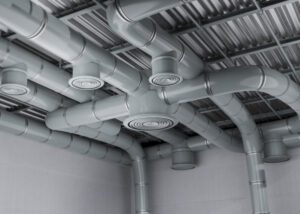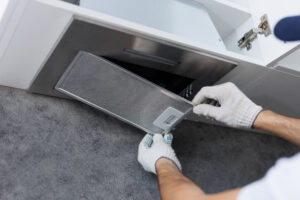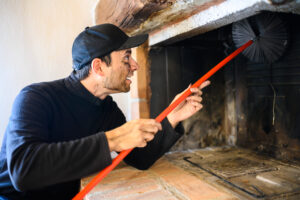A blocked dryer vent is more than a household inconvenience—it’s a serious fire risk that can lead to property damage. Recognizing the early signs of vent blockage helps you prevent danger, extend appliance life, and improve drying performance at home.
Why Dryer Vent Blockages Are a Serious Concern
When hot, moist air from the dryer can’t escape through the vent, it begins to back up into your machine. This causes the system to overheat, reduces efficiency, and can eventually lead to a house fire. Lint and debris around your vent hood signal that it’s time for a full dryer vent inspection. According to the U.S. Fire Administration, over 2,900 home fires annually are linked to dryer issues. Most of these incidents could have been avoided with basic maintenance and awareness of the signs. A clogged dryer vent doesn’t just slow down your laundry—it creates a serious fire hazard hiding in plain sight.
1. Clothes Take Too Long to Dry
If your clothes are taking more than one cycle to dry, your dryer vent might already be partially blocked. This occurs when airflow is reduced, preventing warm air from circulating properly inside the drum. The machine then works harder, consuming more energy without delivering better results. Prolonged drying not only increases energy bills but also strains the internal components of the dryer. Most homeowners blame the appliance, but vent blockages are often the hidden culprit behind declining performance.
2. The Laundry Room Feels Abnormally Hot or Humid
An overheated laundry room is one of the earliest warning signs of restricted airflow from a blocked dryer vent. As heat and moisture fail to escape outdoors, they settle indoors—raising both room temperature and humidity levels. This can lead to peeling wall paint, mold growth, and discomfort during laundry tasks. If you notice unusual warmth near your dryer during operation, turn off the machine and inspect for airflow restrictions immediately. It’s a small signal with potentially huge consequences for your home’s safety.
3. You Notice a Burning Smell While Drying Clothes
Any burning smell coming from the dryer should never be ignored. It usually indicates that lint or debris has come into contact with heating elements. As the machine heats up, trapped material can smolder or ignite, leading to hazardous conditions inside the appliance. The lint trap is your first line of defense against these hazards, but it cannot prevent buildup deep within the vent pipe. Regular cleaning and inspections are essential for preventing fire risks from going unnoticed in everyday use.
4. Excessive Lint Around the Lint T rap or Dryer Door
While the lint trap captures debris, a significant portion can still bypass the screen and accumulate in the vent duct. If you see lint overflowing from the trap area or clinging to the inside of the dryer door, it’s time to act. This buildup signals that the vent is no longer channeling air properly, allowing lint to circulate within the appliance. Ignoring this can lead to costly breakdowns and significantly raise the risk of accidental ignition. Always clean the lint trap after each cycle, but don’t stop there—check your ductwork, too.
5. The Exterior Vent Flap Fails to Open During Use
Most dryer systems have a vent flap or hood located outside the house that opens when air exits through the duct. If this flap isn’t opening while the machine runs, it means airflow is blocked somewhere within the system. Often, this is due to lint, bird nests, or other obstructions in the external pipe. A blocked flap also means hot air remains trapped indoors, which overworks the dryer and reduces efficiency. Observe this component during your next laundry cycle—it’s a simple inspection that could prevent a major problem.
Preventive Maintenance Tips for Safe Dryer Use
Preventing vent blockages begins with awareness and routine maintenance. Clean your lint filter after every load to keep internal airflow steady. Hire a professional to clean the full vent system at least once a year, especially if you notice performance issues. Use rigid or semi-rigid metal ducting instead of flexible plastic tubing, which traps lint more easily. Avoid overloading the dryer, as this restricts tumbling space and promotes lint shedding from clothing. Always ensure the outdoor vent hood is clean and functions properly.
When to Call a Professional for Help
If you’ve checked the lint filter and vent flap but still notice issues, it’s time to contact a certified technician. Professionals use tools like rotary brushes and vacuum systems to clear deep clogs safely and effectively. They can also inspect for vent damage, mold, or signs of nesting animals. Investing in expert cleaning services not only improves performance but also gives peace of mind. Remember—cleaning the surface components is helpful, but internal blockages pose the greatest risk when left untreated.
Final Thoughts
Spotting the signs of a blocked dryer vent early can save you from future fire hazards, repair bills, or appliance failure. A clean system allows hot air to escape efficiently, keeps energy costs low, and protects your property. Always monitor signs like unusual heat, slow drying, and lint buildup around the lint trap and external vent. Keeping these areas clear and scheduling routine inspections ensures long-term safety and performance for every load of laundry you do.
Say Goodbye to Slow Drying Days! Treat your dryer (and your clothes) to a smooth, safe spin—get your vents checked today with Dryer Vent Guardian!





